滚动轴承基础知识详解(SKF版)
- 格式:pdf
- 大小:8.67 MB
- 文档页数:154
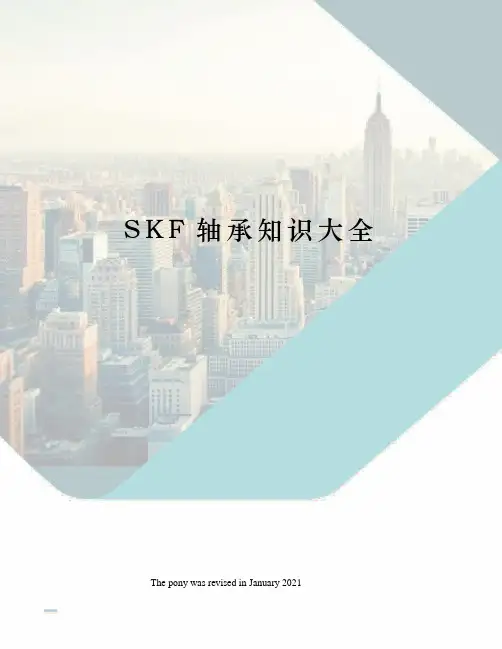
S K F轴承知识大全 The pony was revised in January 2021SKF 轴承知识大全SKF 轴承简介,SKF 轴承型号的含义,NSK 公司概述,SKF 轴承故障排除 and so on.1:SKF 轴承简介:SKF 的全称是“Svenska Kullager-Fabriken”中文音译名称为“斯凯孚”;2:SKF 轴承型号的含义SKF 公司的滚动轴承,滚动轴承部件及附件的完整代号由基本代号和补充代号组成。
基本代号由轴承类型代号,尺寸系列代号和内径代号构成。
表示轴承的基本类型,结构和尺寸,是轴承代号的基础。
补充代号是轴承结构形状,尺寸,公差,技术要求有改变时在基本代号左右添加的代号。
在基本代号左边添加的代号为前置代号,用以识别轴承部件,在基本代号右边添加的代号为后置代号,用以表示与原设计有区别或与现行生产的标准有差异的设计问题。
1)前置代号GS——推力圆柱滚子,推力滚针轴承座圈。
例:GS81107-推力圆柱滚子轴承 81107 的座圈。
K——推力滚子和保持架的组合件里。
例:K81170。
K-——符合 AFBMA 标准系列英制圆锥滚子轴承带滚子和保持架组件的内圈(内锥体)或外圈(锥环)。
例:K-09067——系列为 09000 的圆锥滚子轴承的内锥体。
L——分离型轴承的单一内圈或外圈。
例:LNU207——圆柱滚子轴承 NU207 的内圈。
L30207——圆锥滚子轴承 30207 的外圈。
R——除去单一内圈或外圈的分离型轴承。
例:RNU207——圆柱滚子轴承 NU207 带滚子和保持架组合件的外圈。
R30207——圆锥滚子轴承和保持架组件的内圈。
WS——推力圆柱滚子,推力滚针轴圈。
例:WS81107——推力圆柱滚子轴承 81107 的轴圈。
2.后置代号如果轴承代号中有数个后置代号,则这些后置代号按以下顺序分组排列:(1)内部设计,(2)外部设计,(3)保持架,(4)其他特点。
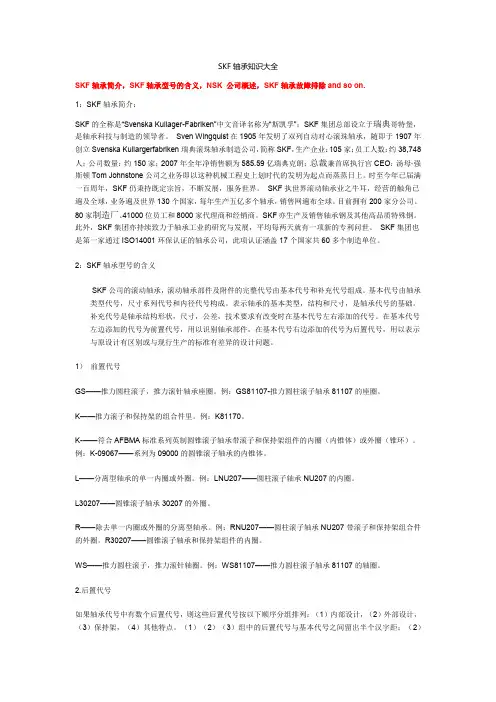
SKF轴承知识大全SKF轴承简介,SKF轴承型号的含义,NSK 公司概述,SKF轴承故障排除and so on.1:SKF轴承简介:SKF的全称是“Svenska Kullager-Fabriken”中文音译名称为“斯凯孚”;SKF集团总部设立于瑞典哥特堡,是轴承科技与制造的领导者。
Sven Wingquist在1905年发明了双列自动对心滚珠轴承,随即于1907年创立Svenska Kullargerfabriken瑞典滚珠轴承制造公司,简称SKF,生产企业:105家;员工人数:约38,748人;公司数量:约150家;2007年全年净销售额为585.59亿瑞典克朗;总裁兼首席执行官CEO:汤母·强斯顿Tom Johnstone公司之业务即以这种机械工程史上划时代的发明为起点而蒸蒸日上。
时至今年已届满一百周年,SKF仍秉持既定宗旨,不断发展,服务世界。
SKF执世界滚动轴承业之牛耳,经营的触角已遍及全球,业务遍及世界130个国家,每年生产五亿多个轴承,销售网遍布全球。
目前拥有200家分公司、80家制造厂、41000位员工和8000家代理商和经销商。
SKF亦生产及销售轴承钢及其他高品质特殊钢。
此外,SKF集团亦持续致力于轴承工业的研究与发展,平均每两天就有一项新的专利问世。
SKF集团也是第一家通过ISO14001环保认证的轴承公司,此项认证涵盖17个国家共60多个制造单位。
2:SKF轴承型号的含义SKF公司的滚动轴承,滚动轴承部件及附件的完整代号由基本代号和补充代号组成。
基本代号由轴承类型代号,尺寸系列代号和内径代号构成。
表示轴承的基本类型,结构和尺寸,是轴承代号的基础。
补充代号是轴承结构形状,尺寸,公差,技术要求有改变时在基本代号左右添加的代号。
在基本代号左边添加的代号为前置代号,用以识别轴承部件,在基本代号右边添加的代号为后置代号,用以表示与原设计有区别或与现行生产的标准有差异的设计问题。
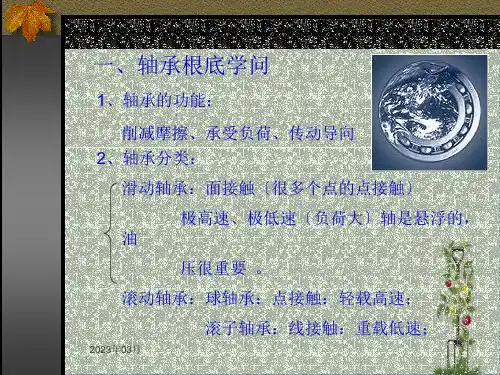

skf进口轴承滚动轴承的转速、参考转速和极限转
速的介绍
1. 转速:SKF滚动轴承的转速通常受到润滑剂温度限值或轴承部件材料的限制。
在达到极限工作温度时,SKF滚动轴承的转速取决于轴承产生的热量、任何外热以及可以从轴承带走的热量。
这些因素受轴承类型和尺寸、内部设计、载荷、润滑以及对中情况的影响,同时还受其他因素的影响,包括保持架设计、精度和内部游隙。
2. 参考转速:SKF滚动轴承的参考转速通常基于ISO15312标准,这是为油润滑制定的ISO标准,也适用于脂润滑。
ISO标准不包括SKF滚动轴承外圈转动的情况。
在SKF滚动轴承外圈转动的应用中,可能需要降低额定参考转速。
3. 极限转速:SKF滚动轴承的极限转速高于参考转速。
对于某些SKF轴承系列,由于摩擦特性好于SKF轴承的机械能力而允许保持高转速,因此参考转速可能高于极限转速。
但是,在任何情况下,必须始终考虑SKF轴承的极限转速,即使是SKF轴承在最有利的工作条件下运行。
需要注意的是,SKF滚子轴承单元的运行转速不应超过产品表中列出的极限转速。
对于带接触式密封的单元,极限转速是由密封唇口的最大表面速度设定的。
对于带非接触式迷宫密封的轴承单元,极限转速取决于轴承和润滑脂。
SKF进口轴承的转速、参考转速和极限转速都受到多种因素的影响,使用时需要参考产品表中的规定,以确保安全有效地使用轴承。
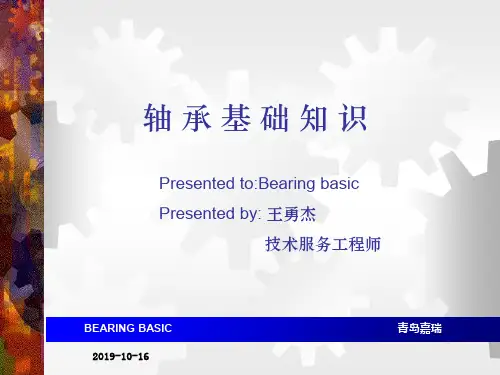
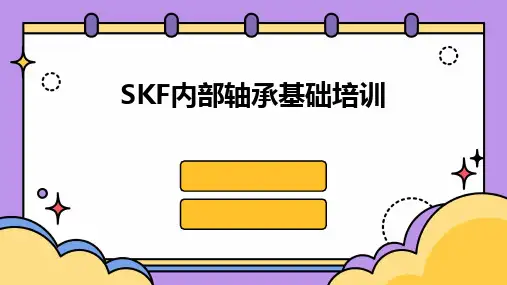
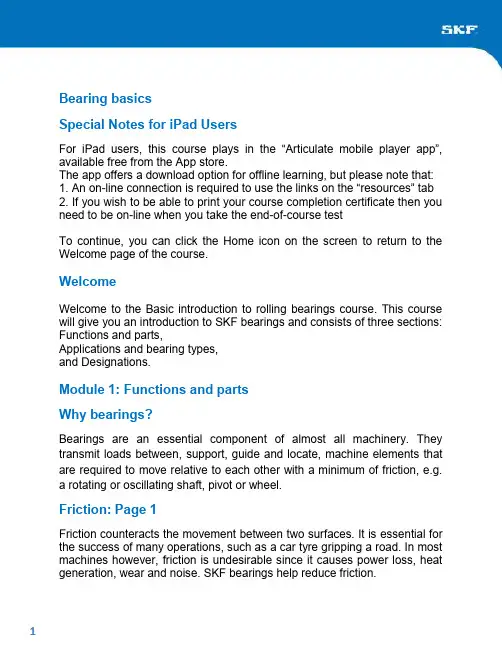
Bearing basicsSpecial Notes for iPad UsersFor iPad users, this course plays in the “Articulate mobile player app”, available free from the App store.The app offers a download option for offline learning, but please note that:1. An on-line connection is required to use the links on the “resources” tab2. If you wish to be able to print your course completion certificate then you need to be on-line when you take the end-of-course testTo continue, you can click the Home icon on the screen to return to the Welcome page of the course.WelcomeWelcome to the Basic introduction to rolling bearings course. This course will give you an introduction to SKF bearings and consists of three sections: Functions and parts,Applications and bearing types,and Designations.Module 1: Functions and partsWhy bearings?Bearings are an essential component of almost all machinery. They transmit loads between, support, guide and locate, machine elements that are required to move relative to each other with a minimum of friction, e.g.a rotating or oscillating shaft, pivot or wheel.Friction: Page 1Friction counteracts the movement between two surfaces. It is essential for the success of many operations, such as a car tyre gripping a road. In most machines however, friction is undesirable since it causes power loss, heat generation, wear and noise. SKF bearings help reduce friction.Friction: Page 2The earliest bearings were mostly made of wood and consisted of a shaft rotating in a hole in a housing, or a wheel rotating on a stationary shaft. Because the components were sliding over each other, friction was relatively high and wear rather rapid.This type of bearing is called a plain bearing and, made of modern materials, is still used in some applications today where speeds and loads are relatively low.Friction: Page 3The introduction of rolling elements between the shaft and the housing greatly reduces friction.Friction: Page 4Today, typical SKF rolling bearings combine maximum load capacity with minimum friction, using hardened steel or ceramic rolling elements, hardened steel inner and outer rings and a cage to guide and separate the rolling elements.Loads: Page 1A bearing can be under radial load, perpendicular to the shaft, or under axial load, acting in the direction along the shaft, or a combination of both radial and axial load, a combined load.Loads: Page 2Large bearings support heavier loads than small bearings can support, and roller bearings support heavier loads than ball bearings can support. Raceway contactThe basic difference between ball bearings and roller bearings is in the contacts between the rolling elements and the raceways. Balls have point contact; rollers have linear contact with relatively larger area.Bearing partsA typical rolling bearing consists of an inner ring, an outer ring and rolling elements contained by a cage. The most common type of rolling bearing is the deep groove ball bearing. These bearings can, as shown here, be supplied with integral seals to retain the lubricant and resist the ingress of contamination.Selection factorsThere are many factors, which will affect the choice of a bearing. These are: Available space, load, required service life, misalignment, speed, stiffness, axial displacement and clearance.Selection factors: SpaceSpace can be an important factor in bearing selection. Where radial space is limited a bearing with small diameter rolling elements, such as a needle roller bearing, may be needed.Selection factors: LoadWhen selecting a bearing, it is important to consider the direction of the load, and the amount of load the bearing will have to carry. A bearing can be under radial load, axial load, or a combination of both.Selection factors: Required service lifeThe life of a bearing can be expressed in terms of: the number of revolutions before failure, the number of operating hours before failure, or the distance covered (for cars and trucks). A bearing is considered to have failed when it shows the first sign of fatigue in a rolling element or raceway, or damage to other parts such as the cage or the seals. Service life is the real life that an individual bearing achieves in a particular application before it has to be replaced. It depends on a variety of influencing factors, including lubrication, the degree of contamination, misalignment, proper installation, and environmental conditions.Because service life cannot be calculated or predicted, bearings are selected using calculated rating life. SKF rating life L10m, a reference value calculated according to statistical methods, using modification factors for lubrication conditions and degree of contamination, and applying the same concept of a fatigue load limit as used in ISO 281, to estimate the life, with 90% reliability, that a sufficiently large population of apparently identical bearings might achieve when all are operating in an identical application.Selection factors: MisalignmentWhere a bearing is likely to be subject to angular misalignment, for example the shaft might bend due to operating loads, appropriate bearings need to be selected. Self-aligning bearings can accept a degree of operational misalignment and can also compensate for limited initial alignment errors in mounting.Selection factors: SpeedThe maximum speed that a bearing can be run in an application is limited by the maximum operating temperature for the materials used in its manufacture, or the lubricant. For high-speed applications minimum possible friction is important, so ball bearings are generally used. Selection factors: StiffnessElastic deformation occurs under load. Usually this deformation is very small and can be ignored. However, in some applications, stiffness is an important factor. Roller bearings have higher stiffness than ball bearings due to the larger area of the line contact.Selection factors: Axial displacementSome applications require bearings that allow the shaft to move axially relative to the bearing. This is called axial displacement. Most often, a shaft is supported by a locating bearing and a non-locating bearing. The locating bearing does not allow axial displacement and keeps the shaft in position. The non-locating bearing supports the shaft and allows displacement to prevent the bearings from being stressed. Cylindrical and CARB toroidalroller bearings can accommodate a limited degree of axial internal displacement.Selection factors: ClearanceThe amount of initial internal radial clearance required in a bearing depends mainly on the fits and temperature gradient between the inner and outer rings of the bearing in the particular application. Operational internal radial clearance is almost always less than initial internal clearance. SKF manufactures bearings with the following ranges of radial internal clearances:•C1 radial internal clearance less than C2•C2 radial internal clearance less than Normal•-- Normal radial internal clearance•C3 radial internal clearance greater than Normal•C4 radial internal clearance greater than C3SummaryIn this lesson, you have learnt about the functions of a bearing. These are: reducing friction, transmitting loads, locating and guiding moving parts. You have also been introduced to the different parts of a bearing: outer and inner rings, rolling elements, cage, and seals and their respective functionalities.Finally, you have also explored the different selection factors, which will affect your choice of bearing: available space, load, required service life, misalignment, speed, stiffness, axial displacement and clearance.Module 2: ApplicationsIntroductionIn this section you will be introduced to the most common bearing types offered by SKF.Electrical motors can be found almost anywhere there is mechanical movement.Motor: Page 2In this drawing you can see that the shaft is supported by two different bearings.Motor: Page 3Cylindrical roller bearings are simply bearings with cylindrical rollers. They can usually accommodate heavy radial loads and can operate at relatively high speeds.Motor: Page 4It is now time to choose the right side bearing.Motor: Page 5Deep groove ball bearings have deep uninterrupted raceways and close osculation between balls and raceways. This enables them to take axial loads in both directions.Pump: Page 1A pump is a device for lifting, transferring or moving fluids by suction or pressure from one position to another. This picture shows a medium-duty process pump, which is often used in refineries.Pump: Page 2In this drawing you can see that the shaft, which is running the impeller, is supported by one deep groove ball bearing to the right, and another bearing or bearings to the left.Single row angular contact ball bearings are widely used in medium and heavy-duty centrifugal pumps. They have raceways arranged at an angle to the bearing axis.Pump: Page 4Single row angular contact ball bearings can only take axial load in one direction. Therefore they are nearly always mounted as pairs in back to back or face to face arrangement at either end of a shaft, or as shown here, universally matchable bearings mounted immediately adjacent to each other.Fan: Page 1This is an industrial fan, in which SKF bearings are commonly used. Industrial fans can either be designed for light loads and high speeds, or for heavy loads and moderate speeds.Fan: Page2A fan is designed with two bearings along its shaft, placed between the fan and the motor. Both bearings carry radial loads and the bearing closest to the fan (on the left hand side here) also needs to be a locating bearing, keeping the shaft and the fan in a fixed position.Fan: Page 3Spherical roller bearings have two rows of rollers with a common raceway in the outer ring. The two inner ring raceways are inclined at an angle to the bearing axis.Fan: Page 4Returning to the fan application again, you now know which bearing is suitable as the locating bearing and here you have to make a guess concerning the non-locating bearing.CARB [ka:b] is a single row toroidal roller bearing with long, slightly crowned, rollers and concave raceways in both the inner and outer rings. Fan: Page 6The complete application looks like this with one spherical roller bearing and one CARB toroidal roller bearing.Separator: Page 1Alfa Laval, a Swedish company, has developed a range of machines specifically designed for rigorous oil processing duties. An example of this would be separators.Separator: Page 2The separation process creates imbalance due to the mud, which is distributed unevenly inside the separator and this makes the spindle bend. Separator: Page 3Self-aligning ball bearings have two rows of balls and a common concave sphered raceway in the outer ring. This makes the bearing insensitive to angular misalignments of the shaft relative to the housing. Self-aligning ball bearings accommodate high speeds due to the point contact between balls and raceways.Refiner: Page 1SKF bearings can be used in refiners in the production of mechanical pulp and other high-yield pulps.Refiner: Page 2In the process wood chips are ground at high mechanical pressure between a stationary disc and a rotating disc, which is powered by an electrical motor. The shaft between the motor and the grinding discs is supported by three bearings.Refiner: Page 3The high production capacity of the refiners is directly related to the demands on the bearing arrangement. The bearings have to provide high stability, operate at high speed, carry high thrust loads and handle deflections of the shaft.Refiner: Page 4The spherical roller thrust bearing incorporates a large number of asymmetrical, spherical rollers and has specially designed raceways. The load is transmitted from one raceway to the other at an angle to the bearing axis and the bearing can carry heavy axial load in one direction and some simultaneously applied radial load as well.Refiner: Page 5This is how the spherical roller thrust bearings are situated in the refiner application.Screw conveyor: Page 1Machines used in the agricultural industry often require bearings that can easily be changed and that can handle misalignments.Screw conveyor: Page 2This is a drawing of a screw conveyor attached to an agricultural machine. The bearings are the only contact between the screw conveyor and the machine.Screw conveyor: Page 3A Y-bearing unit consists of two parts: a housing and a bearing. The bearing is based on the deep groove ball bearing and can carry light radial and axial loads. It has a convex-sphered outside diameter, which allows the bearing to take up misalignment between the shaft and housing at the assembly stage. They are available with a wide range of highly effective,integral seals and a range of different methods for easy mounting to the shaft.Screw conveyor: Page 4This is what the Y-bearing unit looks like in the screw conveyor.Front wheel: Page 1SKF bearings are used in front wheels of commercial vehicles. These applications require bearings that can handle very heavy loads.Front wheel: Page 2This drawing shows how a truck front wheel arrangement is designed and where its bearings are situated. The bearings must carry a large part of the weight of the vehicle and the induced forces when driving, which means that they have to handle heavy loads in both radial and axial directions.Front wheel: Page 3Tapered roller bearings have tapered rollers running in tapered inner and outer ring raceways. This design makes them suitable for handling heavy combined loads.A tapered roller bearing can only carry axial loads in one direction and, for this reason, they are generally fitted in pairs.Front wheel: Page 4See how the tapered roller bearings are mounted in the front wheel of a commercial vehicle.SummaryIn this lesson, you have studied the most common SKF bearing types. Now click on each bearing picture to repeat the most important characteristics of each type. If you want to read more about SKF bearings, enter the SKF Interactive Engineering Catalogue on line at .Module 3: DesignationsIntroductionSKF bearing designations describe a bearing’s or component’s type, design, and variants. The designation can be found both on the box and on the bearing itself.Basic designations: Page 1A bearing designation for metric size bearings can either consist of a basic designation alone or a basic designation plus one or more supplementary designations, called prefixes and suffixes.The basic designation identifies the product type and size, while the supplementary designations identify design, special variants and bearing components.Basic designations: Page 2Each SKF bearing of standard metric design is given a basic designation, which normally consists of three, four or five figures.Basic designations: Page 3For example, the basic designation 22206 denotes a spherical roller bearing with the width series 2, diameter series 2 and a bore diameter of 30 mm.Supplementary designations: Page 1The supplementary designations consist of both prefixes and suffixes. Supplementary designations: Page 2Prefixes are used to identify component parts of a bearing and are usually followed by the designation of the complete bearing.Supplementary designations: Page 3Suffixes are used to identify designs, which differ in some way from the original design. The suffixes are divided into four main groups: Internal design, external design, cage design and variants, all of which are added to the basic designation in this order.End of course testNow it’s time to see what you learned.If you pass the test on-line then you’ll be able to print your course completion certificate.。
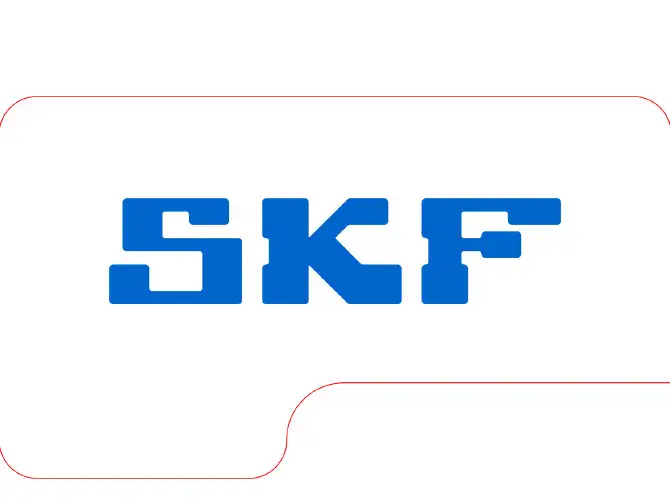

skf轴承手册
摘要:
1.轴承基本概念
2.skf 轴承的分类与特点
3.skf 轴承的安装与拆卸
4.skf 轴承的保养与维护
5.skf 轴承的故障诊断与处理
6.skf 轴承的选购与应用
正文:
SKF 轴承手册概述了轴承的基本概念、SKF 轴承的分类与特点、安装与拆卸、保养与维护、故障诊断与处理以及选购与应用等方面的内容。
轴承是机械传动系统中的重要部件,主要承受轴向和径向载荷,具有支撑、减小摩擦、延长机械寿命等作用。
SKF 轴承作为全球知名品牌,凭借其优质的品质和广泛的产品系列赢得了市场的认可。
SKF 轴承根据承受载荷的方向和大小可分为向心轴承、推力轴承和径向轴承等,根据轴承的结构特点又可分为球轴承、滚子轴承等。
SKF 轴承具有高承载能力、高速性能和低磨损等优点,广泛应用于各类机械设备中。
在安装与拆卸环节,SKF 轴承需要严格按照操作规程进行,避免因安装不当导致的轴承损坏。
保养与维护方面,SKF 轴承需要定期进行清洗、检查和润滑,以确保其正常工作并延长使用寿命。
在轴承使用过程中,可能会出现故障,如噪音、振动等。
SKF 轴承手册提
供了故障诊断与处理的方法,帮助用户及时发现并解决问题。
在轴承选购与应用环节,SKF 轴承手册提供了详细的选型指导,帮助用户根据实际需求选择合适的轴承。
同时,手册还列举了SKF 轴承在不同行业和设备中的应用案例,为用户提供了实际应用中的参考。
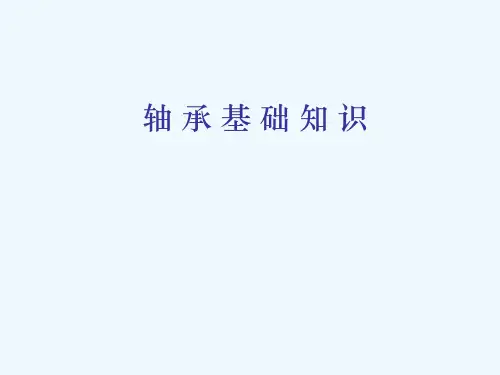
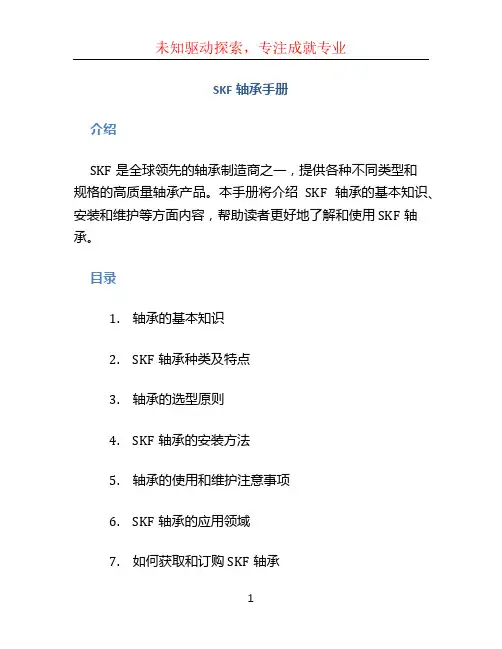
SKF轴承手册介绍SKF是全球领先的轴承制造商之一,提供各种不同类型和规格的高质量轴承产品。
本手册将介绍SKF轴承的基本知识、安装和维护等方面内容,帮助读者更好地了解和使用SKF轴承。
目录1.轴承的基本知识2.SKF轴承种类及特点3.轴承的选型原则4.SKF轴承的安装方法5.轴承的使用和维护注意事项6.SKF轴承的应用领域7.如何获取和订购SKF轴承1. 轴承的基本知识轴承是一种用于减少摩擦和支持机械旋转部件的装置。
它由内圈、外圈、滚动体和保持架组成。
轴承的基本原理是通过滚动体在内圈和外圈之间滚动,从而减少摩擦和支持轴的旋转。
常见的轴承类型包括滚动轴承和滑动轴承。
滚动轴承采用滚动体(如球体或滚子)来减少摩擦,滑动轴承则通过润滑剂减少摩擦。
2. SKF轴承种类及特点SKF生产的轴承种类繁多,包括深沟球轴承、圆锥滚子轴承、圆柱滚子轴承、调心滚子轴承等。
每种轴承都有其特定的应用领域和特点。
•深沟球轴承:适用于高速旋转和较高负载的应用,具有低摩擦和高耐久性的特点。
•圆锥滚子轴承:适用于承受较大径向和轴向负荷的应用,具有高刚度和耐久性。
•圆柱滚子轴承:适用于大型机械设备,具有较高的负载承受能力和良好的耐磨性。
•调心滚子轴承:适用于承受较大偏心或轴向负荷的应用,具有自动调心和高负载承受能力。
3. 轴承的选型原则正确选型轴承对于机械设备的正常运行至关重要。
以下是选型轴承时应考虑的几个因素:•轴承负载:根据机器的负载类型和大小,确定承受能力。
•轴承速度:根据机器的转速要求,选择合适的轴承类型和材料。
•轴承间隙:根据机器的运行条件,选择合适的内圈和外圈间隙。
•环境条件:根据工作环境的温度、湿度等条件,选择合适的轴承材料和润滑方式。
4. SKF轴承的安装方法正确的安装可以确保轴承的使用寿命和性能。
SKF推荐以下安装方法:1.准备工作:清洁轴承座和轴,检查轴承是否有损坏。
2.加热:对于较大尺寸的轴承,可以使用加热器加热轴承或冷却轴座来实现轴承的装配。
轴承是重要的支承零件,根据摩擦方式的不同,轴承可分为滚动轴承和滑动轴承两大类。
滚动轴承是标准组件,由专业工厂大规模生产,在一般机器中广泛使用。
滑动轴承可用于高速、重载、高精度或较大冲击载荷的机器,而需要剖分式结构的场合,则必须采用滑动轴承。
一、滚动轴承的基本类型、选用原则和代号表示法1.基本类型滚动轴承有多种类型,每种类型的轴承都各自具有不同的结构和性能,适用于不同载荷、转速或其他工作要求。
按照轴承所能承受的载荷,轴承又可分为向心轴承、推力轴承和角接触轴承三类,其中每类轴承又可根据其滚动体的形状分为球轴承和滚子轴承。
常用的滚动轴承有1、3、5、6、7、N等六类。
它们的结构特点和性能特点应很好地掌握,以便能正确选用。
同时,还要了解它们的结构图及简图的画法,以便能正确表达。
2.类型选择原则(1)载荷的方向纯径向载荷——向心轴承(6类、N类轴承);纯轴向载荷——推力轴承(5、8类轴承);径向、轴向载荷——向心球轴承(用于轴向载荷较小时);角接触轴承(3类、7类轴承);推力、向心轴承组合(用于轴向载荷较大时)。
(2)载荷的大小与性质一般载荷(轻载、负载平稳)——球轴承;重载荷、冲击载荷——滚子轴承。
(3)转速条件转速高——球轴承(推力球轴承除外)转速较低——滚子轴承(4)调心性能刚度、安装精度差或多支点轴——自动调心轴承(1类、2类轴承)。
(5)装调性能圆锥滚子轴承内外圈可分离,既便于装拆又利于调整轴承间隙。
3.代号表示法滚动轴承的代号由基本代号、前置代号和后置代号构成。
前置代号表示轴承的分部件代号,基本代号表示其类型和尺寸,后置代号为补充代号,表示轴承在结构、公差和材料等方面的特殊要求。
学习者要以轴承的基本代号为重点,熟悉代号中每个数字的意义。
(1)内径尺寸代号位于右起第一、二位数、要注意掌握表达规律。
(2)尺寸系列代号位于右起第三、四位数、表示轴承的直径系列和宽度系列尺寸。
(2)轴承类型代号位于右起第五位数字,表示轴承的类型,向心球轴承可不标注。
Skf 轴承知识 1.概述滚动轴承滚动轴承由于是滚动摩擦,∴摩擦阻力小,发热量小,效率高,起动灵敏、维护方便,并且已标准化,便于选用与更换,因此使用十分广泛。
一、滚动轴承的构造标准滚动轴承的组成:内圈1、外圈2、滚动体3(基本元件)、保持架4一般内圈随轴一起回转,外圈固定(也有相反)内外圈上均有凹的滚道,滚道一方面限制滚动体的轴向移动,另一方面可降低滚动体与滚道间的接触应力。
球——滚珠轴承—— 滚动体的形状 短圆柱形 柱形 长圆柱形螺旋滚子 滚柱轴承 圆锥滚子 鼓形滚子 滚针保持架能使滚动体均匀分布以避免滚动体相互接触引起磨损与发热 二、滚动轴承的材料内、外圈、滚动体;GCr15、GCr15-SiMn 等轴承钢,热处理后硬度:HRC60~65 保持架:低碳钢、铜合金或塑料、聚四氟乙烯 三、滚动轴承的特点优点:1)f 小起动力矩小,η高;2)运转精度高(可用预紧方法消除游隙);3)轴向尺寸小;4)某些轴能同时承受Fr 和Fa ,使机器结构紧凑;5)润滑方便、简单、易于密封和维护;6)互换性好(标准零件)缺点:1)承受冲击载荷能力差;2)高速时噪音、振动较大;3)高速重载寿命较低;4)径向尺寸较大(相对于滑动轴承)应用:广泛应用于中速、中载和一般工作条件下运转的机械设备。
2 滚动轴承的主要类型、特点和代号一、滚动轴承的主要类型与特点接触角α——外圈与滚动体接触处的法线与垂直于轴线的平面的夹角。
类型——按承载方向:向心轴承——︒=0α,主要承受径向载荷,可受一定Fa ,如深沟球、圆柱滚柱轴承等,1、4、6、N 、NA 、2调心滚子等推力轴承——︒=90α,5(推力球),8(推力圆柱滚子)向心推力轴承——︒<<︒900α:︒<<︒450α—向心角接触轴子(0、3、7) ︒<<︒9045α—推力角接触轴承,2(推力调心滚子轴承) 按滚动体形状:球~——承载能力低,极限转速高 滚子~——承载能力高,极限转速低 常用滚动轴承的类型与特性见表注意代号结构特点:承受载荷的大小,方向,极限转速高低,是否有调心性能等 特别注意最常用几种①深沟球轴承(向心球轴承)——6(0)主要承受径向载,也可受一定双向轴向载荷,f 小精度高,结构简单,价格低,最常用。
skf轴承手册SKF轴承手册第一章:引言1.1 概述SKF轴承是一个用于支撑转动机械的工业元件,可以实现旋转和线性运动的各种应用。
本手册将介绍轴承的类型、结构、特点、安装和维护等方面的知识,以便用户正确选择和使用轴承,提高其性能和寿命。
1.2 轴承的作用轴承主要用于支撑旋转机械部件,并传递轴上的力和动力。
轴承重要的功能有:-减少摩擦损失-减少能量消耗-减少振动和噪音-减少维护维修成本-提高机械的可靠性和寿命1.3 轴承的分类轴承根据其结构和用途的不同,可以分为以下几类:-滚动轴承:包括球轴承、圆柱滚子轴承、锥形滚子轴承等。
适用于高速、高精度和高负载的场合。
-滑动轴承:包括滑动轴承和滑动止推轴承。
适用于低速、低摩擦和低噪音的场合。
-滑动滚动轴承:包括滑动滚动轴承和滑动滚动止推轴承。
适用于既需要滚动,又需要滑动的场合。
第二章:滚动轴承2.1 球轴承球轴承是最常见的滚动轴承类型,由内外圈、钢球、保持架和密封圈组成。
它们可以承受来自各个方向的轴向和径向载荷,并适用于中小型机械设备的转动部件。
2.2 圆柱滚子轴承圆柱滚子轴承具有较大的径向载荷能力和较高的刚度,适用于高速和高负载的场合。
它们由内外圈、滚子、保持架和密封圈组成。
2.3 锥形滚子轴承锥形滚子轴承具有较大的径向载荷能力和较高的刚度,适用于受到轴向载荷和径向载荷的同时作用的场合。
它们由内外圈、滚子、保持架和密封圈组成。
2.4 轴承的安装和拆卸在安装轴承之前,必须仔细清洁轴承和轴承座,并涂抹适当的润滑脂。
安装时要遵循正确的方法和使用适当的工具。
拆卸时要注意轴承的位置并使用适当的拆卸工具。
第三章:滑动轴承3.1 滑动轴承的分类滑动轴承按照其用途和工作原理的不同,可以分为滑动轴承和滑动止推轴承。
3.2 滑动轴承滑动轴承是由两个金属表面之间的润滑剂膜支撑着工作的。
它们适用于低速和低摩擦的场合,常见的类型有杂化滑动轴承和复合材料滑动轴承。
3.3 滑动止推轴承滑动止推轴承是在滑动轴承的基础上增加起推力的功能。